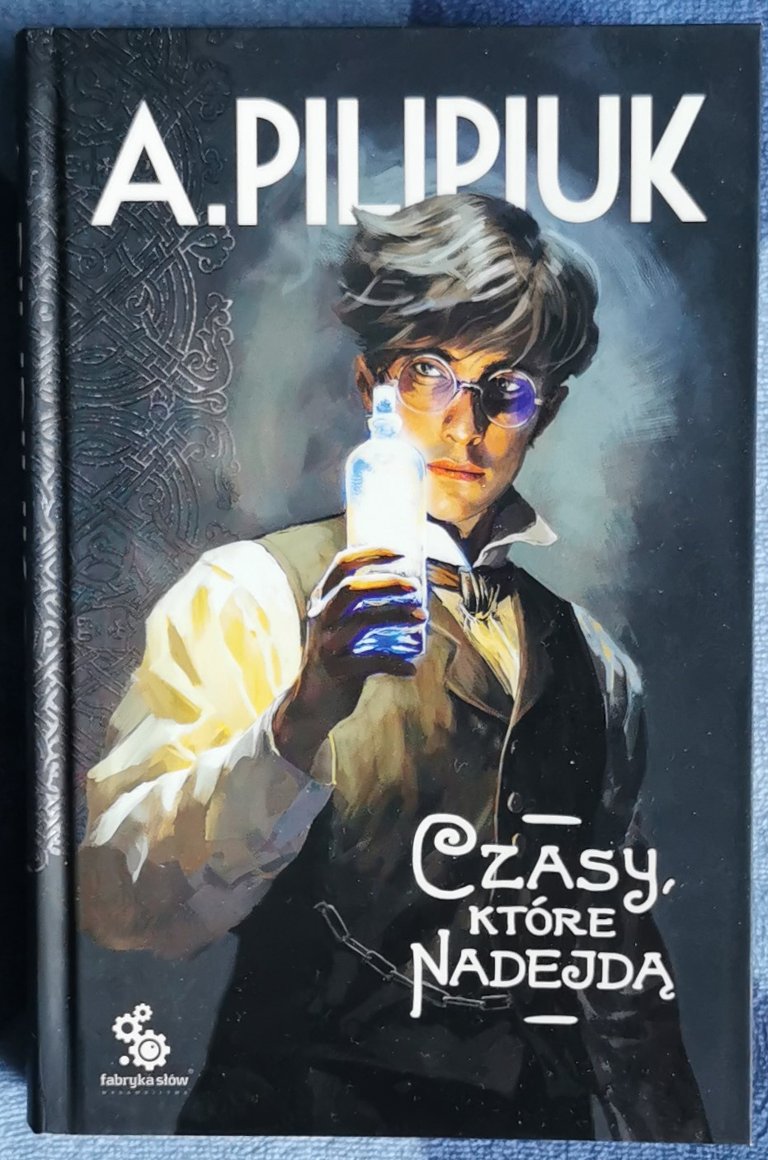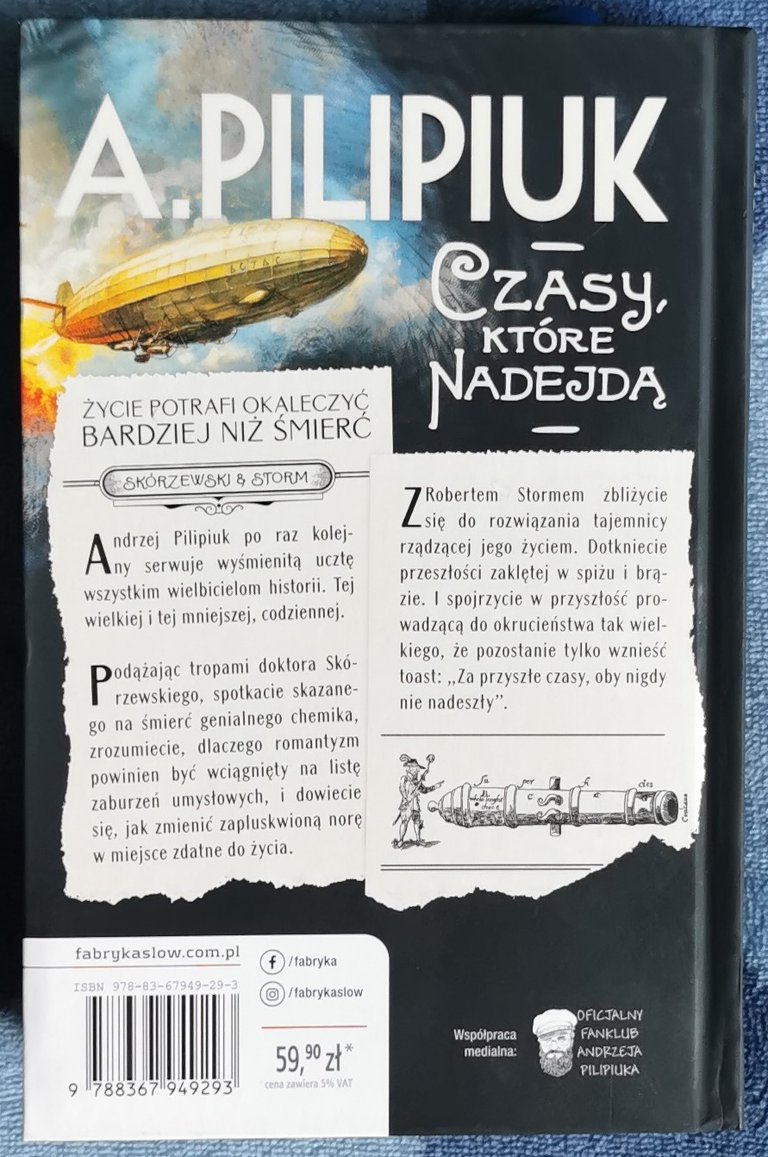
| Najnowszy, czternasty już tom opowiadań Andrzeja Pilipiuka na 373 stronach przynosi nam zaledwie pięć opowiadań. Widać, że tym razem autor postawił na nieco dłuższe formy, co czytelnika zaznajomionego z jego twórczością może napawać lekkim niepokojem – z reguły najlepsze opowiadania Pilipiuka to te kilkunasto-, góra kilkudziestostronicowe. Ale może obawy okażą się niesłuszne? Zobaczmy! Zaczynamy tajemniczym „Remedium”. Skoro Petersburg i koniec XIX wieku, to i doktor Skórzewski. Nasz dobry znajomy podejmuje pracę w szpitalu zakaźnym, leczącym pacjentów chorych na gruźlicę albo syfilis. Czasem na obie te choroby. Chociaż „leczącym” to jednak zbyt optymistyczne słowo – większość z nich jest skazana na śmierć już w momencie przybycia do szpitala, a lekarzom zostaje jedynie nieść ulgę w ich cierpieniach. Wszystko byłoby trywialne – jednak jednym z pacjentów jest dawny kolega Skórzewskiego z czasów studenckich. Stojąc już u wrót śmierci, prosi, by Skórzewski pomógł mu wypróbować eksperymentalną metodę opartą o pleśnie, wymyśloną przez jednego z ich kolegów. Choć wymaga to złamania wielu procedur czy wręcz przepisów, Skórzewski podejmuje ryzyko. Drugie opowiadanie to „Klementynka”. Tym razem bez znanych nam bohaterów. Realia stanu wojennego i czasów Jaruzelskiego skrzyżowane z motywami Czerwonego Kapturka i wierzeń ludowych. Nawet zgrabne i pomysłowe, choć raczej bez jakiegoś głębszego przekazu. Następnie przechodzimy do „Siódmej armaty” i witamy Roberta Storma wraz z pomagającym mu Arkiem. Kiedy Robert postanawia w końcu zadbać też jakoś o własne interesy, sprawy akurat nie idą idealnie tak, jak powinny i rzecz się kończy na policyjnym posterunku. Niemniej cały koncept wcale dobrze spina się z postacią Roberta – są wąsko wyspecjalizowane poszukiwania, jest satysfakcja własna i jest przywrócenie stanu zastanego do stanu sprawiedliwego. A że drogą tak okrężną, jak tylko się dało? No cóż, bywa… Niestety – choć koncept sam w sobie jest niezły, wykonanie, tym razem, nie dorównuje i po lekturze pozostaje niedosyt. Czwarte z kolei opowiadanie to „Profesor Śmierć” – pierwsza wojna światowa, okopy na Zamojszczyźnie i użycie gazów bojowych, nadzorowane przez tytułowego bohatera. Plus tajemniczy żołnierz (bez niego mielibyśmy po prostu dobre opowiadanie wojenne zamiast fantastyki) oraz Jakub Wędrowycz z całym swoim młodzieńczym wyszczekaniem. No i na koniec historia tytułowa – „Czasy, które nadejdą”. Do drzwi Roberta znienacka trafia dziwna postać – ni to dziewczyna, ni to kotka, z prośbą, by uniemożliwił licytację pewnego obrazu olbrzymiej wartości. Niedługo potem, nie odkrywając swojej tajemnicy, umiera. Robert wykorzystuje sieć swoich kontaktów, by zadanie wypełnić, ale czy zdoła? Dlaczego dziwnej istocie zależało właśnie na tym? Skąd przybyła? I kim właściwie była? Pojawia się mnóstwo pytań oczekujących odpowiedzi… Z jakimi wrażeniami zostaje się po lekturze? To trudne pytanie. Niby nie jest to złe, czyta się płynnie, szybko, ale jednak pozostaje pewien niedosyt. Niby od strony tekstowej ciężko jest się do czegoś przyczepić (z drobnymi wyjątkami, o których poniżej), niby opis wydarzeń, miejsc, postaci – jest bardzo realistyczny i można wręcz się poczuć, jakby się było świadkiem opisywanych scen. I to jest świetne. A zarazem czegoś w tych historiach brakuje. Brakuje jakiegoś takiego wstrząsu, który wywoływałby konieczność dłuższej zadumy – jak to już nieraz się zdarzało we wcześniejszych tomach. Momentami też razi to, że poglądy autora zbyt wyraźnie przebijają przez wypowiedzi niektórych postaci. Do tej pory udawało się tego unikać. No i te drobne zgrzyty – pierwszy w opowiadaniu początkowym, gdy lekarze dyskutują o dawnej metodzie leczenia „podobne podobnym” i jeden z nich śmieje się, że dobrze, że dawni lekarze nie wpadli na pomysł leczenia syfilisu muchomorem sromotnikowym, bo ofiar byłoby mnóstwo. Tymczasem naprawdę podobnym (wizualnie) grzybem jest sromotnik bezwstydny, który nie zabija – co najwyżej okropnie śmierdzi. A młode egzemplarze są wręcz jadalne i smaczne. Drugi zgrzyt – gdy Robert i Arek podczas wizyty w cygańskiej chacie zostają określeni mianem „gandzich”. Tymczasem poprawne słowo to „gadzio”. W czasie lektury nasunął mi się chyba jeszcze jakiś trzeci, ale potem umknął z pamięci – więc pewnie był naprawdę drobny. Spośród wszystkich opowiadań najlepszy, moim zdaniem, jest „Profesor Śmierć”. Bardzo dobre opowiadanie wojenne, do tego humor dodany dzięki postaci Jakuba i trochę elementów naukowych, częściowo prawdziwych, częściowo poza naszym zasięgiem, do tego jeszcze powiązania z historią. Tylko niewiele ustępuje mu „Remedium”, które można wręcz potraktować jako studium wpływu przypadku na losy świata – gdyby zamach na cara zdarzył się choć kilka dni później… Trzecie miejsce – „Klementynka” za całkiem dobre przedstawienie realiów i atmosfery stanu wojennego. Bo sama historia – niby w porządku, ale bez wow. I na końcu oba opowiadania o Stormie, mniej więcej na jednym, tym razem niskim poziomie. Ostatecznie dam 7 na 10, ale tylko dzięki opowiadaniom o Skórzewskim. | The latest, fourteenth volume of Andrzej Pilipiuk's short stories brings us just five stories in 373 pages. It is clear that the author has opted for slightly longer forms this time, which may cause concern among readers familiar with his work - usually Pilipiuk's best stories are those of up to several dozen pages or less. But perhaps these fears will prove unfounded? Let's find out! We start with the mysterious 'Remedy'. If we're in St Petersburg at the end of the 19th century, there's also Doctor Skórzewski. Our good friend takes a job at a hospital for infectious diseases, where people are cured of either tuberculosis or syphilis. Sometimes both. Although 'cured' is too optimistic a word - most of them are doomed to die on arrival at the hospital, and all the doctors can do is alleviate their suffering. This would all be trivial, except that one of the patients is a former colleague of Skórzewski's from his student days. On the verge of death, he asks Skórzewski to help him try out an experimental mould-based method invented by one of their colleagues. Even though it means breaking many procedures and even laws, Skórzewski takes the risk. The second story is 'Clementine'. This time without the characters we know. The reality of martial law and the Jaruzelski era crossed with motifs of Little Red Riding Hood and folklore. Quite clever and imaginative, though lacking in any deeper message. We then move on to 'The Seventh Cannon' and welcome Robert Storm along with his helper Arek. When Robert finally decides to take care of his own business, things don't go as planned and he ends up in the police station. Nevertheless, the whole concept fits well with Robert's character - there is a narrow search, there is personal satisfaction and there is the restoration of the status quo to a just state. But taking the most circuitous route? Well, it happens... Unfortunately, although the concept itself is not bad, the way it is implemented this time is not as good as it should be, and the reader is left unsatisfied. The fourth story is 'Professor Death' - the First World War, trenches in the Zamość region and the use of war gases, supervised by the title character. There is also a mysterious soldier (without him we would just have a good war story instead of fantasy) and Jakub Wędrowycz with all his teenage banter. And finally, the title story - 'The Times That Will Come'. Robert is suddenly visited by a strange figure - a cat-like girl - who asks him to stop a valuable painting from getting auctioned. Shortly afterwards, without revealing her secret, she dies. Robert uses his network of contacts to complete the task, but will he succeed? Why did the strange creature want exactly this? Where did she come from? And who exactly was she? A host of questions await answers.... What are your impressions after reading it? That is a difficult question. It's apparently not too bad, it reads smoothly and quickly, but there is still a certain dissatisfaction. Apparently, it is hard to find anything wrong with the text (with minor exceptions, about which more below), apparently the description of events, places, characters - is very realistic, and you can even feel as if you are witnessing the scenes described. And that is great. But at the same time, something is missing from these stories. Some kind of shock that would make you think for a longer period of time is missing - unlike in earlier volumes. Sometimes it is also annoying that the author's views are too clearly expressed in some of the characters' statements. So far this has been successfully avoided. And then there are the little mishaps - the first in the opening story, when the doctors are discussing the old "like for like" method of treatment and one of them laughs that it is a good thing the old doctors did not come up with the idea of treating syphilis with a death cap fungus, because there would have been a lot of victims. Meanwhile, the really similar (visually) fungus is the common stinghorn, which does not kill - at most it smells awful. And young specimens are even edible and tasty. This mistake is caused by the similarity of the names of these fungi in Polish - the common stinghorn is "sromotnik bezwstydny", while the death cap is "muchomor sromotnikowy", and people often shorten it to the incorrect "sromotnik". The second mistake is when Robert and Arek are referred to as "ganjas" during a visit to a gypsy hut. The correct word should be "gadjos". There was probably a third one that occurred to me as I was reading, but then it faded from my memory - so it was probably really minor. Of all the short stories, I think 'Professor Death' is the best. A very good war story, with humour added thanks to the character of Jakub and some scientific elements, partly true, partly beyond our reach, topped off with links to history. 'Remedy' (which could even be seen as a study of the impact of chance on the fate of the world - if the assassination of the Tzar had taken place at least a few days later...) is only slightly behind it. Third place goes to 'Clementine' for its fairly good portrayal of the realities and atmosphere of martial law in Poland. Because the story itself - seemingly okay, but without wow. And finally, both Storm stories, more or less on the same, this time low, level. In the end I give it a 7 out of 10, but only because of the Skórzewski stories. |

It was a good read. I enjoyed one of the doctors who broke rules to cure a certain sickness. It is a good one.
I'm the other hand, you have tried your best to give us the best analysis so far and what is supposed to be or not to be in those stories.
Well done and this I can call "good job".
Thank you!